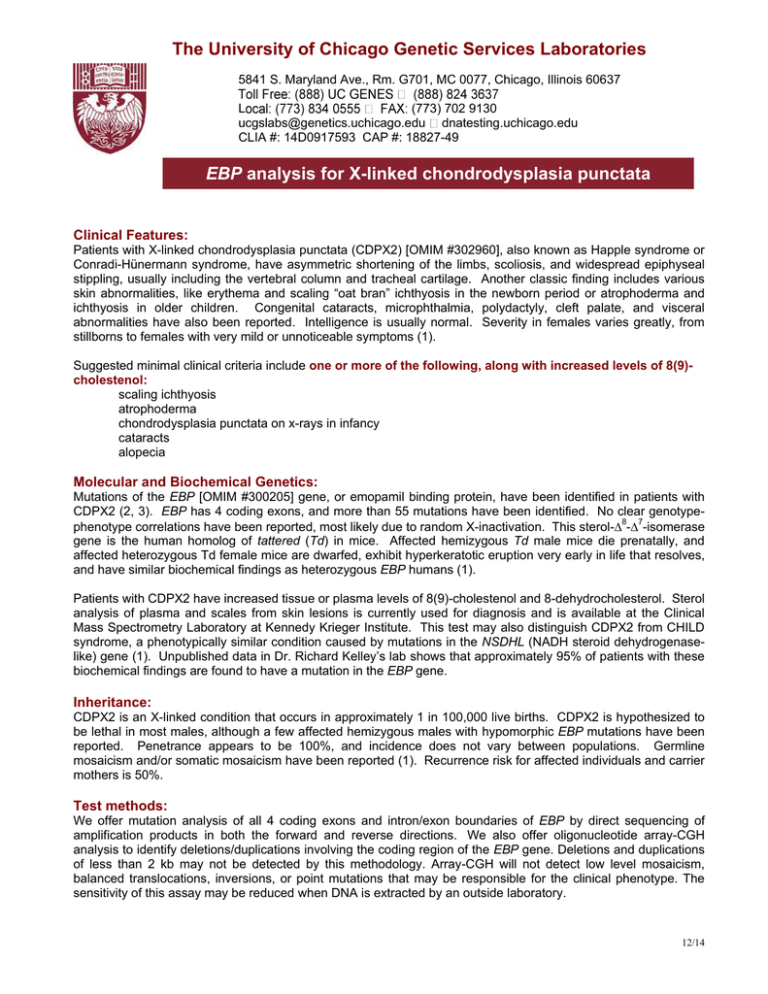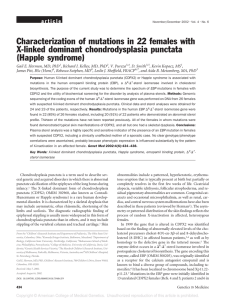Test Information Sheet - The University of Chicago Genetic Services
advertisement

The University of Chicago Genetic Services Laboratories LaboLaboratories 5841 S. Maryland Ave., Rm. G701, MC 0077, Chicago, Illinois 60637 L (773) 702 9130 ucgslabs@genetics.uchicago.edu dnatesting.uchicago.edu CLIA #: 14D0917593 CAP #: 18827-49 EBP analysis for X-linked chondrodysplasia punctata Clinical Features: Patients with X-linked chondrodysplasia punctata (CDPX2) [OMIM #302960], also known as Happle syndrome or Conradi-Hünermann syndrome, have asymmetric shortening of the limbs, scoliosis, and widespread epiphyseal stippling, usually including the vertebral column and tracheal cartilage. Another classic finding includes various skin abnormalities, like erythema and scaling “oat bran” ichthyosis in the newborn period or atrophoderma and ichthyosis in older children. Congenital cataracts, microphthalmia, polydactyly, cleft palate, and visceral abnormalities have also been reported. Intelligence is usually normal. Severity in females varies greatly, from stillborns to females with very mild or unnoticeable symptoms (1). Suggested minimal clinical criteria include one or more of the following, along with increased levels of 8(9)cholestenol: scaling ichthyosis atrophoderma chondrodysplasia punctata on x-rays in infancy cataracts alopecia Molecular and Biochemical Genetics: Mutations of the EBP [OMIM #300205] gene, or emopamil binding protein, have been identified in patients with CDPX2 (2, 3). EBP has 4 coding exons, and more than 55 mutations have been identified. No clear genotypephenotype correlations have been reported, most likely due to random X-inactivation. This sterol-8-7-isomerase gene is the human homolog of tattered (Td) in mice. Affected hemizygous Td male mice die prenatally, and affected heterozygous Td female mice are dwarfed, exhibit hyperkeratotic eruption very early in life that resolves, and have similar biochemical findings as heterozygous EBP humans (1). Patients with CDPX2 have increased tissue or plasma levels of 8(9)-cholestenol and 8-dehydrocholesterol. Sterol analysis of plasma and scales from skin lesions is currently used for diagnosis and is available at the Clinical Mass Spectrometry Laboratory at Kennedy Krieger Institute. This test may also distinguish CDPX2 from CHILD syndrome, a phenotypically similar condition caused by mutations in the NSDHL (NADH steroid dehydrogenaselike) gene (1). Unpublished data in Dr. Richard Kelley’s lab shows that approximately 95% of patients with these biochemical findings are found to have a mutation in the EBP gene. Inheritance: CDPX2 is an X-linked condition that occurs in approximately 1 in 100,000 live births. CDPX2 is hypothesized to be lethal in most males, although a few affected hemizygous males with hypomorphic EBP mutations have been reported. Penetrance appears to be 100%, and incidence does not vary between populations. Germline mosaicism and/or somatic mosaicism have been reported (1). Recurrence risk for affected individuals and carrier mothers is 50%. Test methods: We offer mutation analysis of all 4 coding exons and intron/exon boundaries of EBP by direct sequencing of amplification products in both the forward and reverse directions. We also offer oligonucleotide array-CGH analysis to identify deletions/duplications involving the coding region of the EBP gene. Deletions and duplications of less than 2 kb may not be detected by this methodology. Array-CGH will not detect low level mosaicism, balanced translocations, inversions, or point mutations that may be responsible for the clinical phenotype. The sensitivity of this assay may be reduced when DNA is extracted by an outside laboratory. 12/14 Patients with negative or unknown results can enroll in Dr. Aida Metzenberg’s research study (aida.metzenberg@csun.edu) at the California State University, Northridge for further studies. Please, send a completed CDPX2 Clinical Questionnaire and patient consent form with each sample. This information will be used to aid in interpretation of the test result. With the family’s consent, the clinical data form along with the test result will be shared with Dr. Metzenberg and entered anonymously into a database for research purposes. EBP sequencing analysis Sample specifications: Cost: CPT codes: Turn-around time: 3 to10 cc of blood in a purple top (EDTA) tube $540 81404 4 weeks EBP deletion/duplication analysis Sample specifications: Cost: CPT codes: Turn-around time: 3 to10 cc of blood in a purple top (EDTA) tube $1000 81403 4 weeks Results: Results, along with an interpretive report, will be faxed to the referring physician. Additional reports will be provided as requested. All abnormal results will be reported by telephone. References: 1. 2. 3. Herman GE. Disorders of cholesterol biosynthesis: prototypic metabolic malformation syndromes. Hum Mol Genet 2003: 12 Spec No 1: R75-88. Derry JM, Gormally E, Means GD et al. Mutations in a delta 8-delta 7 sterol isomerase in the tattered mouse and X-linked dominant chondrodysplasia punctata. jderry@immunex.com. Nat Genet 1999: 22: 286-290. Braverman N, Lin P, Moebius FF et al. Mutations in the gene encoding 3 beta-hydroxysteroid-delta 8, delta 7-isomerase cause Xlinked dominant Conradi-Hünermann syndrome. Nat Genet 1999: 22: 291-294. Committed to CUSTOMIZED DIAGNOSTICS, TRANSLATIONAL RESEARCH & YOUR PATIENTS’ NEEDS 12/14

